 Museum
Museum  |
Bomber Command
|
Aircrew Chronicles
|
Aircrew Losses
|
Nose Art
|
BCATP
|
Lancaster
|
Media
|
Bomber Command
|
Aircrew Chronicles
|
Aircrew Losses
|
Nose Art
|
BCATP
|
Lancaster
|
Media
 Museum
Museum  |
Bomber Command
|
Aircrew Chronicles
|
Aircrew Losses
|
Nose Art
|
BCATP
|
Lancaster
|
Media
|
Bomber Command
|
Aircrew Chronicles
|
Aircrew Losses
|
Nose Art
|
BCATP
|
Lancaster
|
Media
Bomber Command Museum Archived Newsletters
|
Visitors to the museum are immediately introduced to one of Nanton's Warren twins as they walk towards the museum entrance. The Bruce Warren Memorial Garden, which now surrounds the three flagpoles and has the museum's CF-100 as a backdrop, was a beautiful tribute to one of Nanton's native sons this summer. The garden was the result of the efforts of museum director Jim Wiersma and his wife Pauline. Fifty years ago, Bruce Warren was killed while testing a prototype CF-100 jet fighter hue to an oxygen system malfunction. The garden was dedicated to his memory at a ceremony on June 24, 2001. In attendance were Bruce's twin, Douglas Warren, Bruce's son Douglas, Douglas's son Bruce, and other members of the Warren family. Col. Don Matthews (Ret'd), a former CF-18 fighter pilot who led the Canadian Air Force in the Gulf War, reviewed Bruce Warren's career. He spoke of the differences between the military of today and that of WWII and of the dedication of such men as Bruce Warren and his twin to the task of winning the air war 1939-45. The garden was dedicated by Rev. Dwight Powell. Duke Warren and Bruce's son Douglas unveiled the engraved black granite monument. |
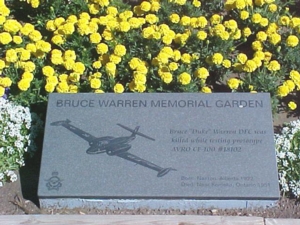 |
 Guest speaker, Major Don Matthews, addresses those assembled for the dedication of the memorial flower garden and plaque honouring the memory of S/L Bruce Warren. Fittingly perhaps is the museum's CF-100 seen in the background as it guards the memorial garden. |
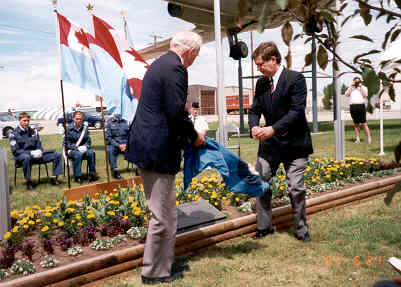 A plaque honouring Bruce Warren is unveiled by his brother Duke and Bruces's son Douglas. The plaque is part of the NLS memorial garden dedicated to Bruce's memory. |
|
The museum's "Women At War" display was officially opened on Saturday, May 26, 2001, with a large crowd filling the museum hanger. Representatives of the wartime RCAF, Women's Division (WDs) and the RAF Women's Auxiliary Air Force (WAAF) were in attendance. Among these were special guests, Lynn Wallace WAAF, RAF Intelligence; Connie Annis WD, Aerial Photography; Cecilia Douglas WAAF, Signals Division; Margaret Smith WAAF; Rosella Bjornson, Canada's first woman airline pilot; and Annett Cantaloupe from Veterans Affairs. Mararet Smith and Cecilia Douglas, both from Calgary, AB, along with Andy Comstock and Gwen Lyon of Nanton officially opened the display with the cutting of a ribbon. NLS President Dan Fox along with Rosella Bjornson then unveiled a special plaque commemorating the 60th anniversary of the Women's Division of the RCAF. Dan Fox reiterated that in excess of 17,000 Canadian women volunteers served 65 non-combatant roles during WWII. |

|
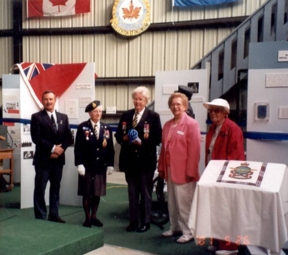
|
Dan Fox stands with Andy Comstock, Nanton; Margaret Smith, Calgary; Cecilia Douglas, Calgary; and Gwen Lyon, Nanton, all of whom served during WWII in various branches of service. Here, they have just cut a ribbon officially opening the new "Women At War exhibit in the NLS Museum. |
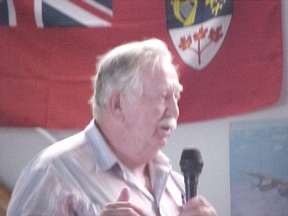 Duke Dawe, former RCAF flight engineer, speaking about his flightsin Lancaster FM159 when it served as a maritime patrol aircraft in the 1950s with 407 Squadron at Comox, BC. He logged some 225 hours in FM159 during the 1950s. |
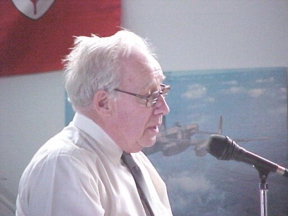 Norm Etheridge speaking at the August 18, 2001 event. Norm was chief engineer in charge of the restoration of the Mynarski Lancaster in Hamilton, Ontario. He told the assembled crowd about the monumental nine-year effort to make this Lanc airworthy. Norm is a good friend and member of the Nanton Lancaster Society and has been very helpful with the on-going restoration of Lancaster FM159. |
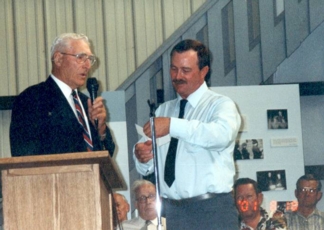 Winston Parker is seen here handing a cheque in the amount of $1000 to Dan Fox. This is a donation from the Southern Alberta Prisoners of War Association. Winston and the POW Assoc. are long time supporters of the museum. |
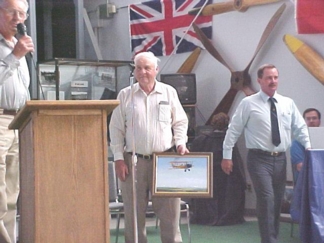 John Green (at the microphone) has just presented Gordon Jones (centre) with the framed enlarged photo of his Tiger Moth. This was a token of appreciation for the numerous times Gordon has flown it for NLS events over the years. |
 X-Terminator nose art reproduced by Clarence Simonsen being unveiled by Howard Witwer, Al McMillan, and Cliff Black. |
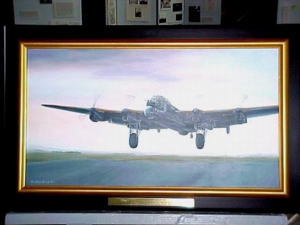 X-Terminator returning from its 84th Operation. |
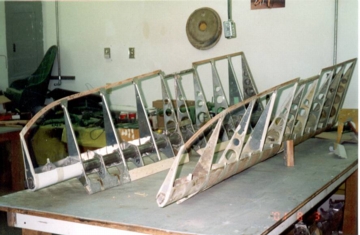 Both ailerons ready for fabric cover. |
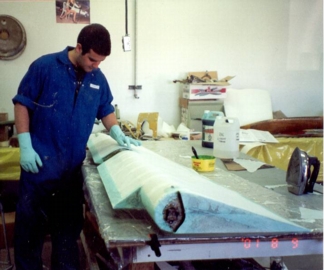 Travis Hutchings checks his fabric work on one of the Blenheim ailerons. |
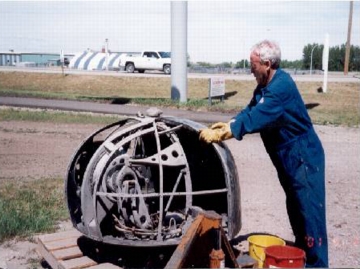 Paul Whitfield cleaning the Lanc turret. |
 Peter Whitfield painting the front turret. |
Guillaume Uziel, from Paris, France, spent five days in Nanton and most of that time he worked in the museum shop. Guillaume is a 16-year-old student who traveled to Canada on his own to work on Lancaster FM-159. He has been a volunteer with the group in France which is restoring the only Lancaster in that country. Guillaume spent his first week in Alberta staying with family friends in Edmonton and volunteered in the Alberta Aviation Museum there before taking the bus to Nanton. In Nanton he stayed with Bob and Carol Evans. The photo above shows Guillaume holding the bomb aimer's compartment handrail which he painstakingly stripped, primed and painted it the NLS shop. He also removed the remains of the the wireless operator's seat cushion and other small items in the Lanc cockpit which are in need of restoration. On Saturday, July 21, 2001, Guillaume attended the fly-in at the AJ Flying Ranch. Here he, along with NLS curator Bob Evans, had a short flight in the 1929 Fokker Universal aircraft, restored and flown by Clark Seaborn of Calgary. Needless to say, this was the highlight of Guillaume's visit to Canada. He indicated the only thing that might exceed this would be to ride in a Lancaster! |
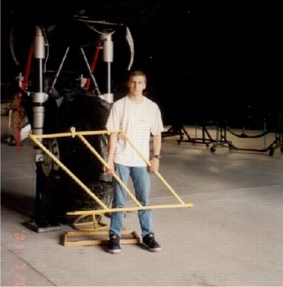 |

 Anson seats, controls and numerous small parts ready for installing on the airframe. |
 Photo shows a trial fitting of the fuselage turtle deck formers. Most of the formers for the fuselage sides are "rough cut" and ready to fit to the tubular frame. |
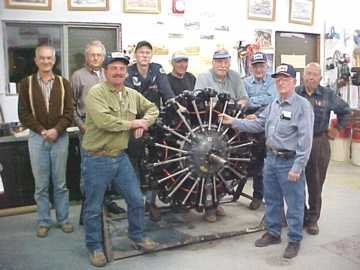
September saw the moving of the local cenotaph to a spot adjacent to the museum. It was formerly located on the other side of town near the north bound #2 highway. This memorial to those who died in two World Wars an in Korea has been part of the Nanton scene since the 1920s. The local branch of the Royal Canadian Legion was responsible for the move. Over the past year they raised the funds necessry to hire a Lethbridge based monument company to relocate the centaph and a local contractor to pour the concrete base in the new location. The main reason for moving the monument was to enable the November 11 Remembrance Day ceremonies to be held in a more suitable place. In the oringinal location, north bound #2 highway traffic had to be diverted or stopped during the ceremony. Also the new location is near the Community Centre. Legion members will no longer have a five block march from the cenotaph for indoor ceremonies after the outdoor salutes. For the museum it adds to the overall theme of remembering those who served. |
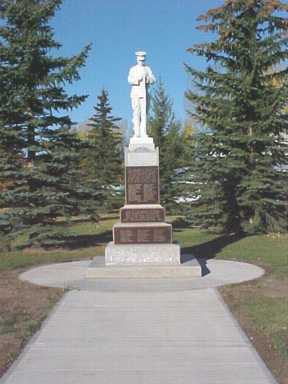 adjacent to the NLS Museum. |
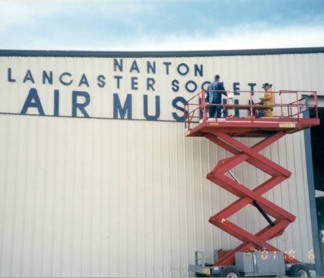
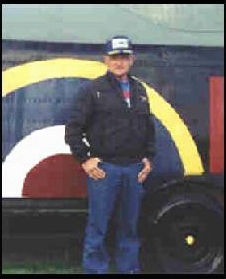
|
Our good friend and exceptional volunteer BOB BRAID passed away suddenly at his home in Nanton, on October 8, 2001. His passing has left a large gap in the ranks of those who are dedicated to the everyday operation of the museum. Bob not only volunteered at the greeting desk, but was forever busy in the museum shop and wherever there was work to be done. His Scottish brogue and friendly manner have made him many friends from near and far. bob and his wife retired to Nanton in 1996 and he almost immediately began to help in the museum. He was a director and a regular in the restoration shop. The Society extends deepest sympathy to Bob Braid's family and friends. May God Bless. |
* Hugh Winslow *
of Nanton, Alberta, passed on in September. he was a local supporter and member.
* Agnes Oakman *
of Swift Current, Sask., passed away October 13. Agnes and her late husband Ernie were major supporters of the museum, having donated the Fleet Fawn, Fairchild Cornell, and numerous other artifacts.
* Jean Armstrong *
of Red Deer, Alberta, passed away May 24. Jean was a lifetime member.